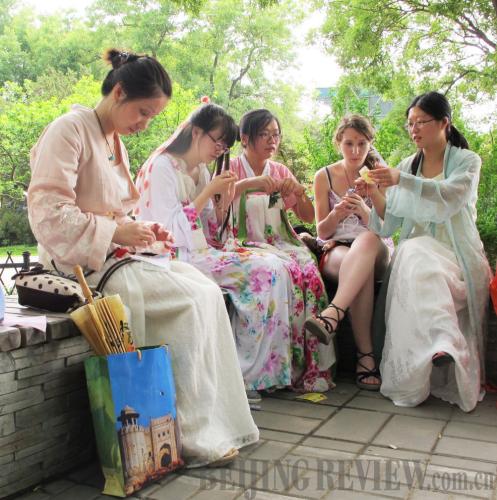|
 |
|
SACHETS AND COLORED ROPES: Traditional culture lovers in Beijing on June 1 gather in Taoranting Park, making fragrant sachets by stuffing cloth bags with herbs like mugwort, whose fragrance will protect the bearer from insects in summer. June 2 was Dragon Boat Festival in China this year, and making such sachets is a traditional custom of the festival (REN DONG) |
Preschool Investment
The Chinese Government's investment in preschool education saw an increase in excess of five times between 2008 and 2012, according to new Ministry of Education data.
Figures revealed in a June 4 statement show that China's spending on preschool education in 2012 reached 74.8 billion yuan ($12 billion), showing an average annual increase of 49 percent each year from the 13.3 billion yuan ($2.13 billion) spent in 2008.
"Both central and local governments regard preschool education as a key aspect in the national education plan, and supporting preschool education is a major project for ensuring and improving people's livelihoods," the statement said.
According to the ministry, the ratio of government spending on preschools in all educational investment also rose from 1.3 percent in 2008 to 3.2 percent in 2012, an increase much higher than for high school, college or vocational education.
Medical Awareness
The Chinese Government released a circular on May 30 that discussed ensuring children remain safe from potentially harmful medications, raising requirements in various aspects such as research and development, supply and quality management.
Released by six departments, including the National Health and Family Planning Commission and the China Food and Drug Administration, the document noted that pharmaceutical companies lack the motivation to research and develop medicines fit for children, and the improper use of medicines still exists.
The circular said that favorable policies will support companies to improve children's products and price them moderately, and the government will coordinate manufacturing, procurement and storage of medicines that are crucial and might easily run out so as to ensure there is enough for clinical use.
In addition, it urged regulation of traditional Chinese medicines for children's use concerning their functions, consumption, dosage and adverse reactions.
Insurance for Orphans
More than 60,000 Chinese orphans received free health insurance contracts on May 30.
Under a joint insurance program supported by the Ministry of Civil Affairs and the China Children Insurance Foundation (CCIF), each insured child is covered for 100,000 yuan ($16,000) at a premium of 50 yuan ($8) a year to cover the cost of treating 12 critical illnesses, including malignant tumors and conditions requiring organ transplants, said Heidi Hu, CCIF's Managing Director.
An insurance fund created through donations will be accessible for one year starting on June 1, according to Hu.
The program was launched in 2009. Insurance contracts have also been donated to children whose families have financial difficulties.
China has more than 570,000 officially registered orphans. However, the actual number is believed to be higher, as some in remote rural areas might have been missed, while other orphans being raised by migrant worker relatives might not be counted when they move to big cities. | 